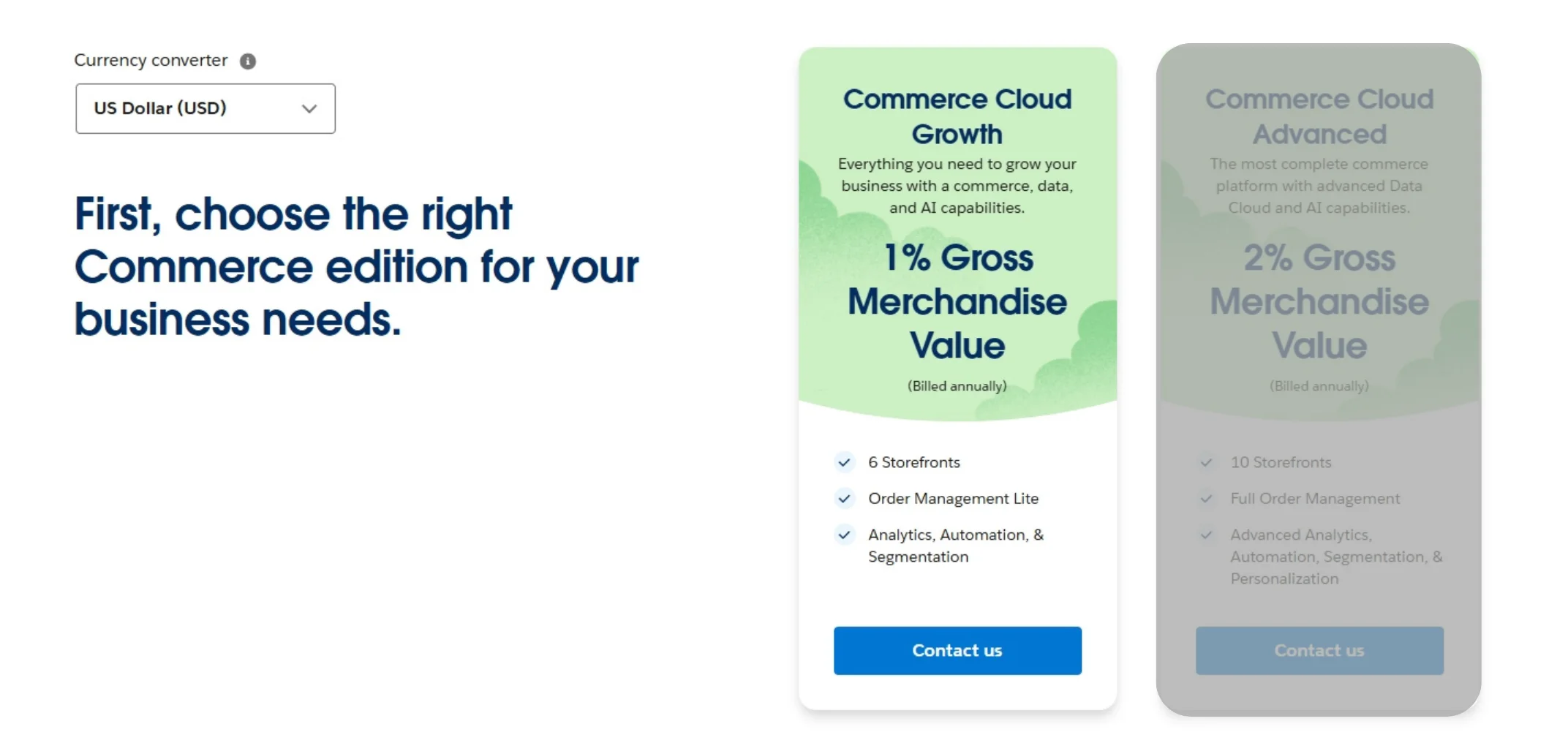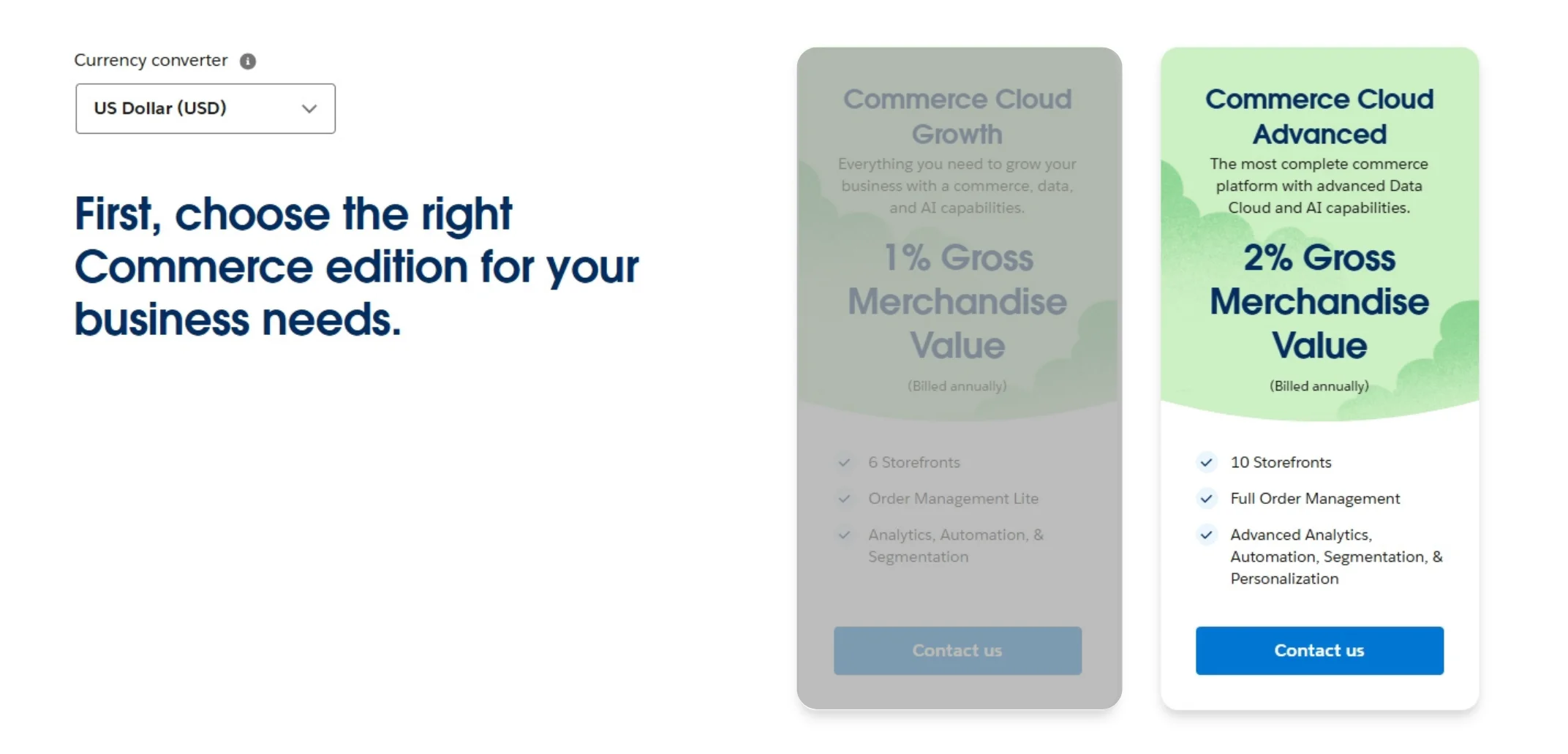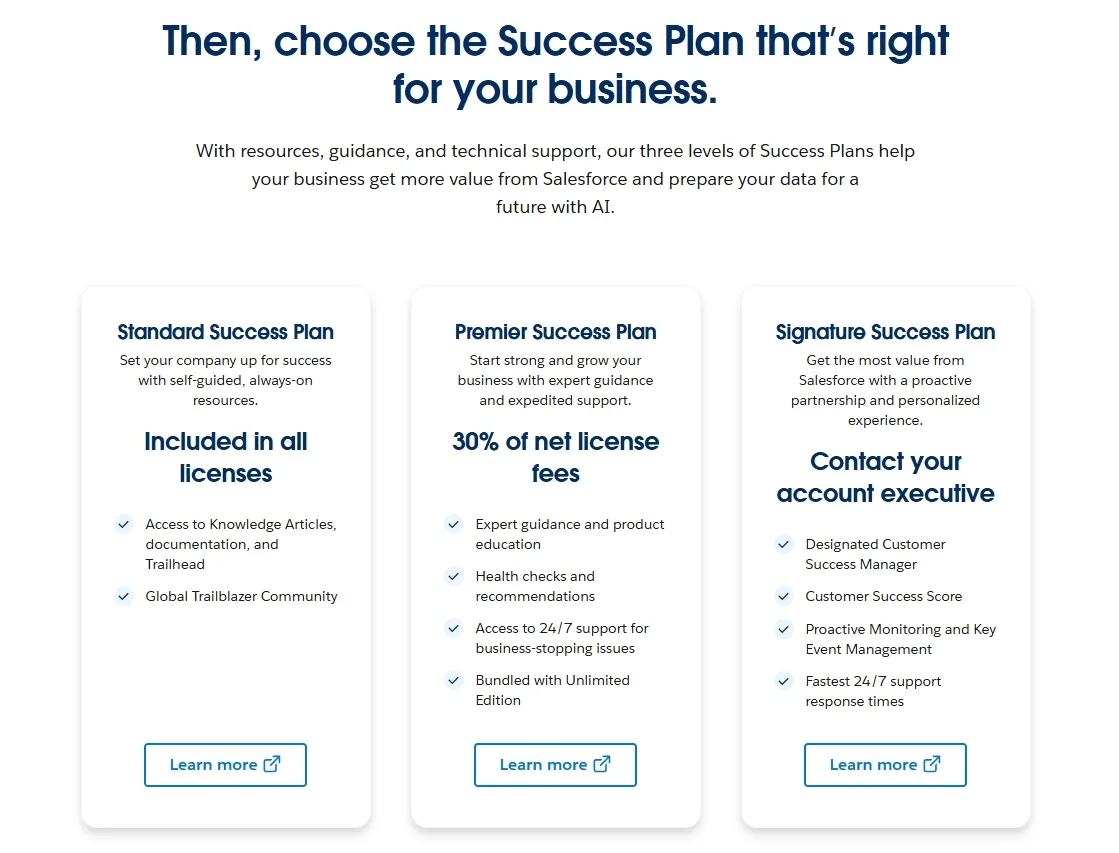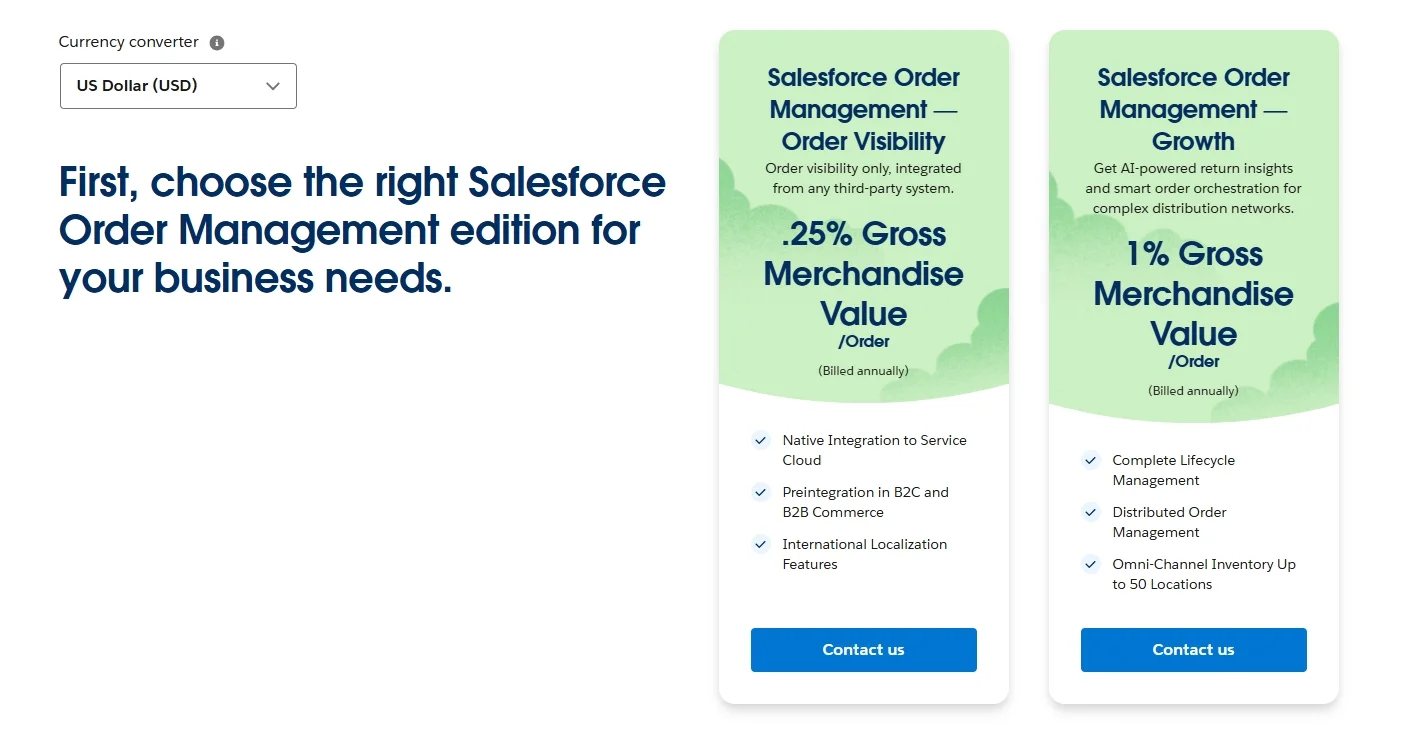Understanding Salesforce B2B Commerce pricing is essential for any business planning to move its B2B sales online. However, finding clear pricing information can be challenging since this platform does not always list exact costs upfront.
To help you understand the full cost breakdown of Salesforce B2B Commerce pricing, we will discuss everything you need to know in this article. Keep on reading for:
- Salesforce subscription fee
- Other costs you need to consider
- Frequently asked questions on the pricing of Salesforce B2B Commerce
Without further ado, let's get started!
Salesforce B2B Commerce Pricing Breakdown
Salesforce offers B2B Commerce solutions through two main editions, Commerce Cloud Growth and Commerce Cloud Advanced. Each edition is designed to serve businesses at different stages of digital maturity, with pricing models based on usage and order volume rather than flat monthly fees.
In this section, we'll break down what each plan includes, who it's best suited for, and what you can expect in terms of Salesforce B2B Commerce pricing. While Salesforce does not publish fixed rates on its website, we’ll outline the typical pricing structures and help you estimate potential costs based on your business needs.
Commerce Cloud Growth
Commerce Cloud Growth is Salesforce’s entry-level B2B Commerce solution, designed for mid-sized businesses that are beginning to digitize their sales processes. It offers a solid foundation for companies looking to launch a scalable online storefront without the complexity of advanced customization.
This edition includes core features such as:
- Multiple B2B storefronts
- Integration with other tools in the Salesforce ecosystem, like Agentforce or Data Cloud
- Order management tool
- CRM analytics

When it comes to Salesforce B2B Commerce pricing, the Growth edition follows a usage-based pricing model, charging business owners 1% of their Gross Merchandise Value with an annual billing period. This means that if the total value of products sold on your store is $1M, you'll need to pay a Salesforce B2B Commerce pricing of $10,000 a year.
This tier is ideal for companies that need robust commerce capabilities with a lower barrier to entry, while still benefiting from Salesforce’s CRM ecosystem. However, businesses with complex workflows or higher transaction volumes may outgrow this edition over time and require the flexibility offered in the Advanced plan.
Commerce Cloud Advanced
On the other hand, Commerce Cloud Advanced is Salesforce’s enterprise-grade B2B Commerce solution, built for large businesses or those with complex digital commerce needs. It expands significantly on the Growth edition, offering deeper functionality, greater customization options, and advanced integrations.

In terms of Salesforce B2B Commerce pricing, the Advanced edition follows a similar GMV-based model, but with higher pricing thresholds. By upgrading to this tier, you'll need to pay 2% of your Gross Merchandise Value. For example, if your total product revenue is $1M a year, the annual subscription fee for the Advanced edition will be $20,000.
This edition provides the scalability and flexibility that larger enterprises need to compete in a rapidly evolving B2B eCommerce landscape. However, the additional cost should be weighed against the operational value and automation benefits it offers.
Salesforce Commerce Cloud Growth vs Advanced
Commerce Cloud Growth | Commerce Cloud Advanced | |
Storefronts | 6 storefronts | 10 storefronts |
Inventory Locations | 20 inventory locations | 20 inventory locations |
Order Management | Order Management Lite | Full Order Management |
Data Cloud for Commerce | Analytics & Segmentation | Advanced Analytics & Segmentation |
Data Cloud Credits | 250K credits | 500K credits |
Agentforce | Merchant Agent | Merchant Agent |
Einstein Requests | 60K requests | 120K requests |
CRM Analytics | 3 users | 5 users |
Knowledge Management | 3 users | 5 users |
Other Salesforce B2B Commerce Fees
While the main subscription cost is a major factor, it's important to understand that Salesforce B2B Commerce pricing often includes additional fees beyond the core platform. These extra costs can significantly impact your total investment, especially as your business scales or requires more advanced capabilities.
In this section, we’ll cover the most common supplemental fees you may encounter. This includes support plans, order management services, and the cost of integrating third-party apps or tools. Knowing these expenses upfront will help you budget more accurately and avoid surprises later in the implementation process.
Salesforce Success Plan
When considering Salesforce B2B Commerce pricing, it's important to account for support options that go beyond the standard license. Salesforce offers three levels of Success Plans, each designed to help businesses get the most value from their investment, whether you're just starting out or managing complex enterprise needs.

1. Standard Success Plan – Included in all licenses
This plan is ideal for businesses that prefer self-guided support. It provides:
- Access to Knowledge Articles, technical documentation, and Trailhead learning modules.
- Entry to the Global Trailblazer Community for peer-to-peer support and shared insights.
A good thing is that the Standard Success Plan doesn't charge you a single penny, as it comes with all Salesforce licenses.
2. Premier Success Plan – 30% of net license fees
This plan is designed for growing businesses that need more hands-on assistance. By upgrading to this plan, you'll get:
- Expert guidance on products and training.
- Regular health checks and personalized recommendations.
- 24/7 support for urgent, business-critical issues.
- Bundled access to Salesforce’s Unlimited Edition for broader feature access.
Pricing for this plan is typically 30% of your net license fees, which means if your Salesforce subscription is $10,000, you'll need to pay $3,000 for this plan.
3. Signature Success Plan – Custom pricing
Tailored for large enterprises, this plan provides the highest level of personalized service. Key features include:
- A Designated Customer Success Manager for direct account support.
- A custom Customer Success Score and metrics.
- Proactive monitoring and key event management.
- Salesforce’s fastest 24/7 response times for urgent issues.
For this plan, businesses must contact their Salesforce account executive to receive a custom quote based on their scale and support needs.
Order Management pricing
Salesforce B2B Commerce pricing can rise significantly when you add Salesforce Order Management (SOM), a separate module designed to handle the post-purchase experience, from order tracking to fulfillment and inventory management. Salesforce offers two main Order Management options, each with different features and pricing models based on Gross Merchandise Value (GMV).

1. Order Visibility Edition – 0.25% GMV
This entry-level option is ideal for businesses that only need basic post-order tracking and visibility. It includes:
- 360-degree customer view
- Native integration with Service Cloud
- Preintegration in B2C Commerce Cloud
- International localization features
However, it lacks features like distributed order management, omnichannel inventory, and complete lifecycle tracking, making it better suited for companies with simpler fulfillment processes.
2. Growth Edition – 1% GMV
The Growth tier provides a comprehensive order management solution and is best for businesses with higher volume and more complex fulfillment needs. It includes all features from the Order Visibility plan, plus:
- Complete lifecycle management (from order placement to returns)
- Distributed order management
- Omnichannel inventory tracking (supports up to 500 locations)
While the 1% GMV pricing is significantly higher, it delivers a much broader set of tools for managing operations across multiple sales channels and fulfillment points.
Salesforce apps integration
When evaluating the total cost of ownership for Salesforce B2B Commerce, one often-overlooked factor is the cost of integrating third-party applications. While Salesforce provides a powerful and flexible platform, most businesses will require additional tools or services from the Salesforce AppExchange.
Salesforce’s AppExchange offers a wide range of apps across categories like marketing automation, ERP integration, payment processing, product recommendation engines, analytics, and more. While some of these apps are free, especially basic utilities or tools from Salesforce Labs, many advanced or mission-critical apps require separate licenses or subscriptions.

These costs are not included in the base Salesforce B2B Commerce pricing, but they are essential for many businesses to achieve full functionality.
On top of that, in cases where no off-the-shelf solution exists or when businesses have highly specific requirements, custom integrations are often necessary. These projects may involve:
- Hiring a Salesforce development partner
- Building and maintaining custom APIs
- Ongoing security updates and troubleshooting
- Managing API usage limits (as Salesforce may charge for excess calls)
This level of customization can lead to significant implementation and long-term maintenance costs, often surpassing initial platform fees.
Salesforce B2B Commerce Pricing – FAQs
What is Salesforce B2B Commerce?
Salesforce B2B Commerce is a cloud-based eCommerce platform built specifically for business-to-business transactions. It allows companies to create personalized storefronts for their buyers, manage complex pricing and contracts, and streamline bulk ordering, all while leveraging Salesforce’s powerful CRM and automation tools.
What is the difference between B2B commerce and B2C commerce in Salesforce?
The key difference lies in the buying experience and platform capabilities:
- B2B Commerce is designed for wholesale and corporate buyers. It includes account-based pricing, contract management, bulk ordering, and multiple buyer roles per account.
- B2C Commerce is optimized for retail-style transactions with individual consumers. It focuses on marketing, product discovery, and fast checkout for high-volume, low-complexity sales.
Both are built on the Salesforce Commerce Cloud but serve very different customer journeys.
Can Salesforce be used for B2B?
Yes, Salesforce is one of the leading platforms for B2B commerce. Its B2B Commerce Cloud integrates tightly with Salesforce CRM, giving businesses a unified view of their customers, sales reps, and service teams. It supports advanced B2B needs like custom catalogs, quote-to-order workflows, and ERP integrations.
Is Salesforce too expensive for small business?
Salesforce B2B Commerce is generally tailored for mid-sized to large enterprises, and its pricing reflects that. While the Growth edition offers a lighter option, costs can still be substantial, especially when adding Success Plans, order management, and app integrations. For smaller businesses with limited budgets, platforms like Shopify Plus or BigCommerce may offer more affordable entry points with less complexity.
Final Verdict
In short, when it comes to Salesforce B2B Commerce pricing, the platform offers powerful enterprise-level capabilities, but it also comes with premium costs that go beyond the standard license fees.
Salesforce’s tiered pricing model, paired with additional fees for support, order management, and integrations, means businesses must evaluate the total cost of ownership, not just the base rate. The Commerce Cloud Growth edition provides a solid entry point for mid-sized businesses, while the Advanced tier caters to enterprises with high-volume, complex requirements.
Ultimately, Salesforce B2B Commerce is best for companies that view digital commerce as a long-term investment and have the internal resources or partner support to make the most of the platform’s ecosystem. If that's your position, the return on investment can be significant.
Last but not least, please don't forget to check out other articles on our LitExtension blog for more expert tips and insights.

